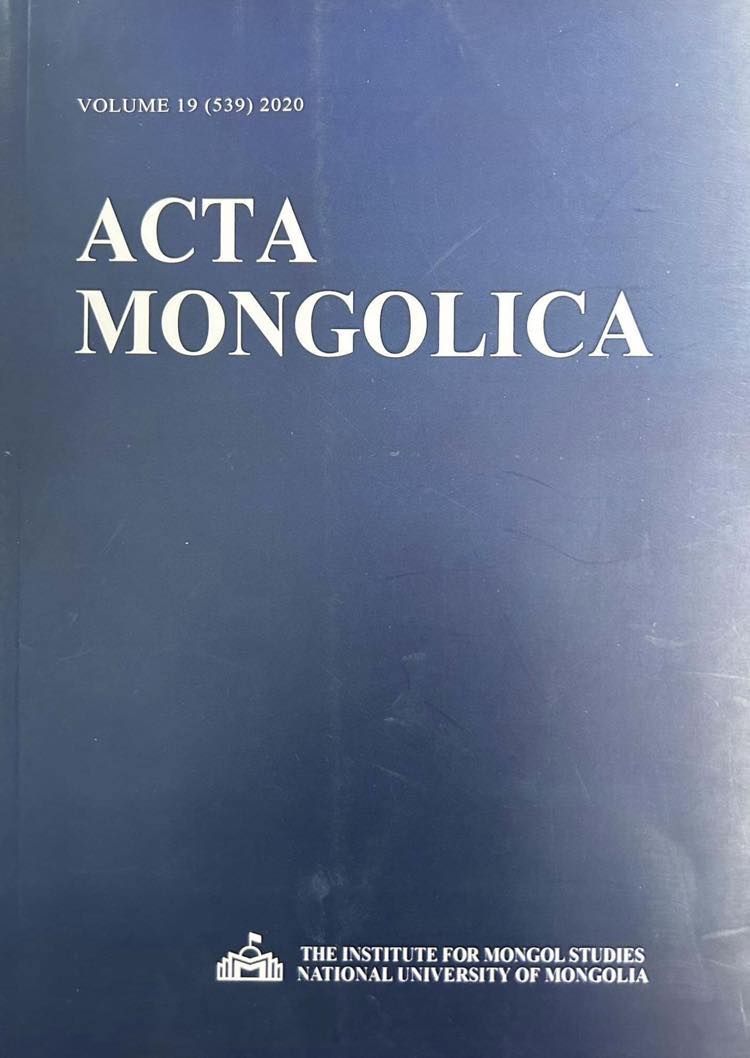Mongol Nuudel Tradition, Changes, and Memory
Main Article Content
Abstract
Based on the memory and experience of some local elderly herders and a case of some current seasonal nüüdels (travels) in the west of Mongolia, this article provides a comparative illustration on how practices of nüüdel from one pasture to another differ from those conducted in socialist times. Using the reconstruction of a ‘traditional’ nüüdel and following some existing literature on nomadism and pastoralism, this article intends to show that nomads are not barbarian wanderers who constantly move around in the ‘free’ and/or ‘unoccupied’ landscape. Based on ethnographic fieldwork, it provides a detailed illustration of indigenous experience and knowledge on the pasture, landscape, climate and the environment; techniques to pack, unpack and to safely lead a caravan; love and care for herd animals; division of labor in the household and interaction and collaboration of local people; and customs and treatments to the local spirit masters.
Article Details

This work is licensed under a Creative Commons Attribution-ShareAlike 4.0 International License.
References
Baumann, Brian. 2008. Divine Knowledge: Buddhist mathematics according to Antoine Mostaert’s “Manual of Mongolian Astrology and Divination”. Leiden: Brill.
Bumochir, Dulam. 2017. “The Afterlife Nomadism: Pastoralism, Environmentalism, Civilisation and Identity in Mongolia and China.” In Pastoralist Livelihoods in Asian Drylands: Environment, Governance and Risk, edited by Ariell Ahearn and Troy Sternberg. Cambridge: The White Horse Press.
Chatty, Dawn. 1986. From Camel to Truck: The Bedouin in the Modern World. New York: Vantage Press.
Dulam, S. 2013. Mongol Soyol Irgenshliin Utga Tailal (Interpretation to Mongol Culture and Civilization). Ulaanbaatar: Bit Press. Hannam, Ian. 2007. “International Perspectives on Legislative and Administrative Reforms as an Aid to Better Land Stewardship.” In International Perspectives on Legislative and Administrative Reforms as an Aid to Better Land Stewardship, edited by Victor Squires. London: Springer
Humphrey, C., & Sneath, D. 1999. The End of Nomadism? Society, State and the Environment in Inner Asia. Leiden: Brill.
Fraser, R. 2018. “Motorcycles on the Steppe: Skill, Social Change, and New Technologies in Postsocialist Northern Mongolia.” Nomadic Peoples 22(2): 330–368.
Tomorjav, M. and Khurelbaatar, N. 2017. Mongol malchny erdem ukhaany deej orshiv (Masterpiece of Mongolian herders’ knowledge and intelligence). Ulaanbaatar: TEPE Print.
Rossabi, M., & Rossabi, M. 2006. “Namkhainyambuu and the Changes in the Herding Economy of Mongolia.” In Mongolians from Country to City: Floating Boundaries, Pastoralism and City Life in the Mongol Lands, edited by Ole Bruun & Li Narangoa, 185–211. Copenhagen: NIAS Press.
Sonompel, T. 2012. Mongolyn mal aj akhuin tüükhen khögjil, orchin üye (Historical development and the modernity of Mongolian pastoralism). Ulaanbaatar: Möröödliin Gurvaljin.
Williams, D. M. 2000. “Representation of Nature on the Mongolian Steppe: An Investigation of Scientific Knowledge Construction.” American Anthropologist, 102(3): 503–519.
Yembuu B. 2016. “Mongolian Nomads: Effects of Globalization and Social Change.” In Everyday Knowledge, Education and Sustainable Futures: Transdisciplinary Approaches in the Asia-Pacific Region, edited by Margret Robertson and Po Keung Eric Tsang, 89–105. Singapore: Springer.

